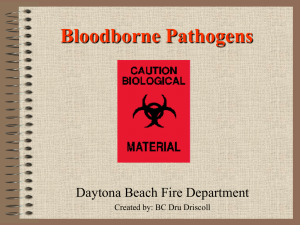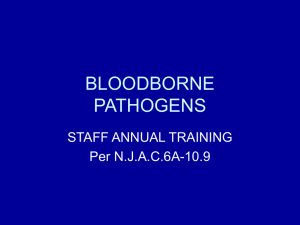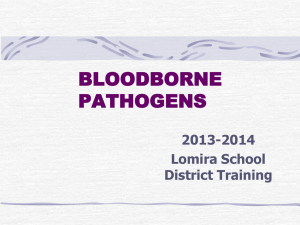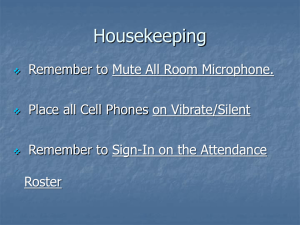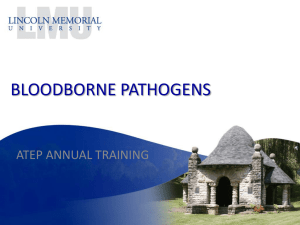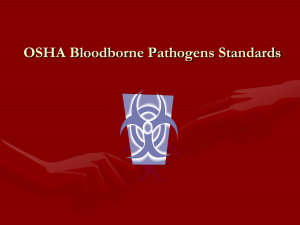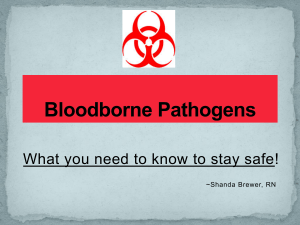document? - Bartlesville Public Schools
advertisement
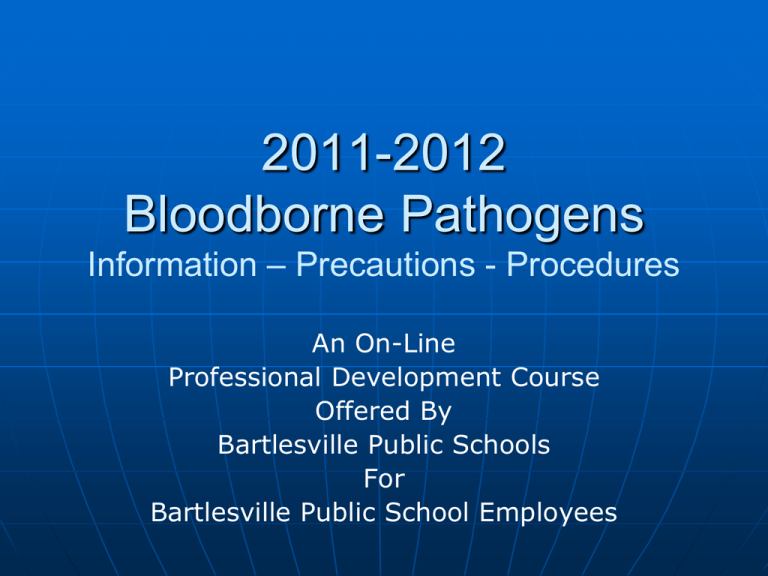
2011-2012 Bloodborne Pathogens Information – Precautions - Procedures An On-Line Professional Development Course Offered By Bartlesville Public Schools For Bartlesville Public School Employees Required Professional Development In accordance with the OSHA Bloodborne Pathogens Standard 29 CFT 1910.1030 all Bartlesville Public School employees must ANNUALLY receive bloodborne pathogen training. 2 This self-paced course will: • Provide information about bloodborne pathogens (BBP) and the diseases they can cause and • Outline precautions and procedures you should take to protect yourself and others from exposure to bloodborne illness. 3 BBP Training Objectives To eliminate or minimize job related exposure to bloodborne pathogens (BBP) To provide some information about the potential sources of bloodborne pathogen (BBP) exposure in the school setting To provide some information about diseases transmitted by bloodborne pathogens (BBP) To review some universal precautions for limiting exposure to bloodborne pathogens (BBP) To review some procedure you should take if you experience a potential bloodborne pathogen (BBP) exposure 4 Course Credit Throughout this course key points will be highlighted with review questions and answers. At the end of the course Bartlesville Certified teachers Certified building principals Certified special education paraprofessionals Other designated staff may access a quiz to document participation in Bloodborne Pathogens training for the period July 1, 2011 through June 30, 2012. 5 What Are Bloodborne Pathogens? Bloodborne Pathogens are microorganisms such as viruses or bacteria that are carried in blood and can cause disease in people. These pathogens include viral hepatitis, human immunodeficiency virus (AIDS), malaria, rabies, syphilis and brucellosis. 6 Where Are They Found? In the school setting potentially infectious materials are most often found in human body fluids such as: • Blood • Saliva • Vomit • Urine • Semen • Vaginal secretions A blood test is required to confirm a BBP infection. 7 Who Is At Risk of Exposure School employees have a low to moderate risk of exposure to bloodborne pathogens. Employees most at risk of exposure are: • School Nurses • Athletic Coaches • Custodians • Special Education Teachers • Regular Classroom Teachers Because risks for exposure do exists, all Bartlesville Public School employees must be prepared to respond using standard precautions. 8 How Does Exposure Occur? In the school setting potential exposure to bloodborne pathogens occur most often from direct contact with: Body fluids from the nose, mouth and eyes that contain blood Bleeding wounds caused by cut, punctured and abraded skin Bleeding skin conditions such as acne and athlete’s foot Human bites by students Chronic or sudden on-set diarrhea or vomit that is 9 contaminated with blood How Does Exposure Occur? In the school setting exposure to bloodborne pathogens occurs most often when you and/or an offending party transfers infectious blood products from their body, a surface or an object to your mouth, eyes, nose or skin. Skin exposure can occur through open cuts, nicks, abrasions, dermatitis and acne. 10 Pathogens of Greatest Concern The pathogens of primary concern are: • Hepatitis B virus (HBV) • Hepatitis C virus (HCV) • Human immunodeficiency virus (HIV) 11 Hepatitis B Virus (HBV) Scientifically classified as Hepadnavirus Contains deoxyribonucleic acid (DNA) Hepatitis B virus (HBV) is 100 times more infectious than HIV, the virus that causes AIDS About 5% of Americans have been infected with HBV at some point during their lifetime. If you get infected with HBV you can also get infected with the hepatitis D virus (HDV). If this happens, you may become very sick. 12 Hepatitis B Virus (HBV) HBV is found in the blood and body fluids of an infected person. HBV can live for an extended time – over one week - in dry blood and on dry surfaces. Average incubation period (the time between the initial exposure to the virus and the development of symptoms of the HBV disease) is about 16 weeks. In the school setting the most common method of exposure is through direct contact with blood from an open wound or from a human bite from an infected person. 13 Chronic Hepatitis B (HBV) About 1.25 million people living in the United States have chronic (life-long) HBV infection. They might not look or feel sick. People who have chronic HBV infection may be “hepatitis B carriers”. They can spread HBV to others. About 15% to 25% of persons with chronic HBV infection die from liver cirrhosis or liver cancer. Chronic infections occurs in” • 90% of infants infected with HBV at birth • 30% of children infected between birth and 5 • 6% of people infected after age 5 14 Hepatitis B Virus (HBV) Symptoms Not everyone will present symptoms. Adults and teens will have symptoms more often than young children. Symptoms you my experience: • Tiredness • Loss of appetite • Fever • Diarrhea • Dark urine • Light-colored stools • Jaundice (yellow skin and eyes) 15 Hepatitis B Virus (HBV) Vaccine Hepatitis vaccines are safe and effective. Adult protection will last for up to 15 years. Hepatitis B vaccine is recommended for : • All infants • All children and adolescents • School employees in higher risk job assignments - School Nurses - Athletic Coaches - Special Education Teachers Hepatitis B vaccine for adults is usually given as three shots over a 4-6 month period. 16 Hepatitis B Prevention In the school setting The most effective way to prevent exposure to the Hepatitis B virus is to wear gloves if you have to touch anyone’s blood. If your skin is exposed to blood or body fluids, immediately wash the exposed area with soap and water Flush exposed eyes, mouth or nose with water for at least 15 minutes. If you are exposed to blood or body fluids file an exposure report with your immediate supervisor and request the Hepatitis B vaccine. 17 Hepatitis B Treatment There is not treatment for acute (new infection) hepatitis B For chronic (life-long) hepatitis B, antiviral medicines are available: • Treatment may take as long as a year • Medicines are effective in reducing liver damage in about one-half of patients. Liver transplant • Over time your liver may stop working and you may need a new liver from a donor 18 Hepatitis C Virus (HCV) Scientifically classified as Flavivirus Contains ribonucleic acid (RNA) Approximately 4 million American have been infected with hepatitis C virus (HCV) 8,000 – 10,000 Americans die from HCV-related illness each year Chronic liver disease, caused by HCV is the #1 reason for liver transplantation in the U.S. 19 Hepatitis C Virus (HCV) HCV is found in the blood and body fluids of an infected person. Average incubation period (the time between the initial exposure to the virus and the development of symptoms of the HCV disease) is 7 to 9 weeks. In the school setting the most common method of exposure is through direct contact with blood from an open wound or from sharing items that have blood on them 20 Hepatitis C Virus (HCV) Symptoms Not everyone will have symptoms. Adults and teens will have symptoms more often than young children. Symptoms you my experience: • Tiredness • Loss of appetite • Fever • Stomach ache • Diarrhea • Dark urine • Light-colored stools 21 • Jaundice (yellow skin and eyes) Hepatitis C Prevention In the school setting The most effective way to prevent exposure to the Hepatitis C virus is to wear gloves if you have to touch anyone’s blood. Do not share items that may have blood on them If your skin is exposed to blood or body fluids, immediately wash the exposed area with soap and water Flush exposed eyes, mouth or nose with water for at least 15 minutes. If you are exposed to blood or body fluids file an exposure report with your immediate supervisor. 22 Hepatitis C Treatment There is no treatment for acute (new infection) hepatitis C For chronic (life-long) hepatitis C, antiviral medicines are available: • Treatment may take as long as a year • With treatment about 50% of patients get rid of the virus Liver transplant • Over time your liver may stop working and you may need a liver transplant 23 Human Immunodeficiency Virus (HIV) HIV is a bloodborne infectious disease The human immunodeficiency virus (HIV) is most likely the cause of acquired immune deficiency syndrome (AIDS) Once a person has been infected with HIV, it may be several years before AIDS actually develops HIV attacks and weakens the body’s immune system AIDS is a fatal disease In the school setting the most likely way for transmitting HIV is through contact with infected human blood and any body fluid visibly contaminated with blood 24 Stages of HIV/AIDS HIV/AIDS infection occurs in three broad stages First Stage • Begins when a person is first infected with the human immunodeficiency virus (HIV) • The infected person may experience a brief, mild flu-like illness shortly after infection • After the initial infection, a person may show few or no signs of illness for many years • The latency period may last from 7 to 12 years from infection to the development of AIDS 25 Stages of HIV/AIDS HIV/AIDS infection occurs in three broad stages Second Stage • Starts when the infected person begins to experience frequent respiratory ailments and suffer from swollen lymph glands and other conditions that take advantage of the body’s weakened immune system • As the second stage progresses bouts with illness become more frequent and severe • It is believed that during the second stage HIV transitions to AIDS 26 Stages of HIV/AIDS HIV/AIDS infection occurs in three broad stages Third Stage • The body becomes progressively unable to fight off infections • The immune system is severely weakened and life threatening diseases become a major concern • A person infected with AIDS is more likely to die from a disease that takes advantage of the body’s weakened immune system than from the human immunodeficiency virus 27 HIV/AIDS Symptoms An infected person can pass on the HIV infection before symptoms appear Symptoms of HIV infection can vary and often include: • Physical weakness • Fever and sore throat • Nausea • Headaches • Diarrhea • Thrush (a fungal infection of the mouth) • Weight loss 28 • Swollen lymph glands HIV/AIDS Prevention HIV is a fragile virus and will not survive for long outside the human body In the school setting, the most effective way to prevent exposure to HIV is to: • Practice and use universal precautions • use appropriate protective equipment including gloves if you have to touch blood or body fluids contaminated with blood • Properly dispose of any materials contaminated with blood and other body fluids. • Document and report any potential exposure to your immediate supervisor immediately 29 HIV/AIDS Prevention In the school setting, those most at risk of HIV infection are: • School nurses • Custodians • Special education teachers • Regular Classroom teachers Exposure and transmission are most likely to occur while: • Providing first aid to students • Cleaning up vomit and blood in bathrooms, hallways and classrooms 30 HIV/AIDS Treatment There is no known cure for HIV/AIDS Persons infected with HIV/AIDS should take precautions to prevent exposure to diseases that may further weaken their immune system Anti-retroviral therapies can reduce the number of viral organisms in the blood of an infected person to below detectable levels, usually within 4 to 6 weeks (This does not mean the person is “cured of HIV”.) 31 Standard Precautions/Risk Reduction “Standard precautions” are procedures used to reduce risks of exposure to bloodborne pathogens In applying standard precautions, you should always treat blood and body fluids “as if they are infectious materials” Standard precautions should be used even when you think there is no risk involved The use of standard precautions will help to protect Bartlesville Public School employees and our students from contact with infectious agents. 32 Standard Precautions/Risk Reduction Bartlesville school employees should know and use the following standard precautions for risk reduction: Hand Hygiene Disposal of sharps and glass Decontamination of surfaces Disposal of materials contaminated with blood and body fluids Document all exposure incidents Request hepatitis B vaccine 33 Standard Precautions – Hand Hygiene The single most effective way to prevent bloodborne pathogen exposure in the school setting is to use standard precaution hand hygiene including: • Hand washing using soap and water • Hand washing using alcohol-based hand rubs • Proper use of protective gloves Even if your hands appear to be clean, the process of providing first aid or cleaning up a contaminated area may lead to hand contamination 34 Hand Hygiene – Soap & Water Use soap and water to clean hands when: • Hands are visibly dirty • Hands have been contaminated with blood or body fluids • You have handled contaminated materials • You remove protective gloves Liquid soap is preferred to bar soap Warm or tepid water is preferred to cold water Running water is preferred to a bowl of water 35 Hand Hygiene – Soap & Water The Center for Disease Control recommends the following hand washing method for soap and water: Wet hands with water Apply a quarter size dollop of liquid hand soap to the palm of one hand Rub hands together for at least 15 seconds, covering all surfaces , focusing on fingertips and fingernails Do not use a scrub brush Rinse under running water Dry with a disposable towel 36 Use towel to turn off the faucet Hand Hygiene – Alcohol Rubs Alcohol-based hand rubs (foam or gel) are more effective in killing bacteria than soap and water Alcohol-based hand rubs are less damaging to the skin than soap and water, resulting in less dryness and irritation. Alcohol-based hand rubs require less time than hand washing with soap and water Alcohol-based hand rubs can be placed at the point of need so they are more accessible Alcohol-based hand rubs are the preferred method for hand hygiene in all situations except: • When hands are visibly dirty • Hands have been contaminated with blood or 37 body fluids Hand Hygiene – Alcohol Rubs The Center for Disease Control recommends the following hand washing method for alcohol rubs: Apply to palm of one hand the amount of rub recommended on the label Rub hands together covering all surfaces , focusing on fingertips and fingernails until hands are dry Use enough rub to require at least 15 seconds for hands to dry 38 Hand Hygiene - Gloves Gloves should be used when hands may become contaminated with blood or body fluids, or when touching contaminated surfaces or objects Common problems with glove use in a school setting are failure to: • Wear gloves when touching an open wound • Wear gloves when touching items that are likely to be contaminated with blood or body fluids • Change gloves between students • Change gloves if a tear or puncture occurs • Remove gloves after problem is mitigated 39 Hand Hygiene - Gloves Gloves should be made of latex, nitril, rubber or other water impervious materials Put gloves on without touching the inside of the glove except with the skin of your hand Remove gloves carefully so the outside of the glove does not touch your bare hand or other skin Dispose of used gloves in a container reserved for contaminated item, so no one can come in contact with them Do not reuse or wash disposable gloves Use standard precaution hand hygiene to wash hands immediately after removing gloves 40 Standard Precautions – Needles Needles should never be recapped, broken or sheared Needles should only be disposed of in labeled sharps containers Sharps containers should be closable, punctureresistant, leak proof on the sides and bottom and must be labeled Sharps containers should have a secure, closable cover to prevent spillage when handled All needles should be handled as contaminated material 41 Standard Precautions – Glass Broken glassware that has been visibly contaminated with blood or other body fluids must be sterilized with an approved disinfectant solution before it is disturbed or cleaned up. (See your custodian for appropriate disinfectant) Broken glassware that has be decontaminated may be disposed of in an appropriate sharps container – closable, puncture-resistant, leak proof on sides and bottom and labeled Broken glass must be swept or brushed into a dust pan. Broken glass must never be picked up directly with the hands 42 Standard Precautions – Surfaces All surfaces – floors, tables, books, etc – that come in contact with blood or potentially infectious materials must be decontaminated as soon as possible and before the surface is returned to normal use. Building custodians have received specialized training and can help you with surface decontamination If the building custodian is not available and you have not received specialized training in surface democratization, restrict access to the contaminated area until the custodian can 43 decontaminate the area Standard Precautions – Disposal of Contaminated Materials All materials contaminated with blood or body fluids should be handled as regulated waste Regulated waste should be disposed of in properly labeled containers or red biohazard bags. Building custodians have received training in how to dispose of contaminated materials. Non regulated waste may be disposed of in regular plastic trash bags 44 Standard Precautions – Post Exposure Follow-Up Any Bartlesville Public School employee who experiences a potential bloodborne pathogen exposure shall document and report the incident. The employee shall document: • The time and location of the incident • The parties involved in the incident • How the exposure occurred • The standard precautions followed to mitigate the incident The employee shall report the incident to their immediate supervisor. 45 Standard Precautions – Hepatitis B Vaccine A Hepatitis B vaccine shall be available to any employee who experiences a potential exposure to bloodborne pathogens. The following conditions may qualify as exceptions: • The employee has previously received the complete Hepatitis B vaccination series • Antibody testing reveals that the employee is immune • The vaccine is contraindicated for medical reasons • The employee declines the vaccination 46 Hepatitis B Vaccination Refusal If an employee initially declines the Hepatitis B vaccination; but later decides to accept the vaccination, the vaccination shall then be made available. If an employee declines the Hepatitis B vaccination when offered, the employee shall be required to sign the OSHA required waiver indicating their refusal. 47 Bloodborne Pathogen Exposure Control Plan Each school site is required to have a written Bloodborne Pathogen Exposure Control Plan. The plan must include: • • • • • Purpose of plan Scope (who is at risk of exposure) Responsibilities (job assignments) Training schedule and content Engineering and work controls (procedures for limiting exposure) • Procedures for reporting incidents and potential exposure • Procedure for requesting Hepatitis B vaccine The plan must be accessible to all employees The plan must be reviewed and up-dated at least annually 48 Responsibility of Principals Principals shall have the responsibility for ensuring that all employees in their building Receive Bloodborne Pathogen training annually Have access to necessary supplies to protect themselves and all students including • • • • • Gloves and protective equipment Soap Bleach and disinfecting agents Brooms and dust pans Appropriate disposal containers Practice universal precaution hand hygiene Have access to Hepatitis B vaccinations if exposure occurs Report potential exposures to Human Resources Monitor building Bloodborne Pathogen Exposure Control Plan 49 Responsibilities of Teachers and Other Building Staff Teachers and other building staff shall have the responsibility for: Participating in Bloodborne Pathogen training annually Knowing where protective supplies are kept Knowing how to protect themselves and all students in the building from potential bloodborne pathogen exposure Practicing universal precaution hand hygiene Helping students practice universal precaution hand hygiene Reporting potential bloodborne pathogen exposures to the principal Requesting a Hepatitis B vaccine if potential exposure to bloodborne pathogens has occurred 50 Responsibilities of Building Custodians Building custodians receive specialized training for cleaning up and disposing of potentially infectious materials. Ask your building custodian for help: When cleaning up potentially infectious bodily fluids such as blood, vomit and urine In disinfecting surfaces contaminated with potentially infectious bodily fluids such as blood, vomit and urine When disposing of cleaning materials contaminated with potentially infectious bodily fluids such as blood, vomit and urine 51 Responsibilities of School Nurses and First Aid Responders School nurses and first aid responders receive specialized training for assisting teachers and students with open wounds and chronic and sudden on-set illness. Ask your school nurse or first aid responders for help: When you or a student needs treatment for an open wound When you or a student experience loss of blood, vomit or urine in the classroom, in the school building or on school property 52 Course Review Bloodborne pathogens are microorganisms such as virus and bacteria that are carried in blood and body fluids and can cause disease in people. Bloodborne pathogens are found in human body fluids such as blood, saliva, vomit, and urine. School employees have a low to moderate risk of exposure to bloodborne pathogens. Employees most at risk are school nurses, athletic coaches, custodians, special education teachers and classroom teachers. Exposure to bloodborne pathogens can occur when contaminated blood comes in contact with open cuts, skin nicks, abrasions, dermatitis, acne and athletes foot. 53 Course Review Bloodborne pathogens of greatest concern in the school setting are hepatitis B, hepatitis C and HIV. Hepatitis vaccine is safe and effective. Adult protection can last up to 15 years. Teachers who are exposed to blood or body fluids should file an exposure report with their principal and request a hepatitis B vaccine. Hepatitis B virus is many times more infectious than HIV or hepatitis C virus. “Standard precautions” are procedures used to reduce risks of exposure to bloodborne pathogens. 54 Course Review Standard precaution hand hygiene is the single most effective way to prevent bloodborne pathogen exposure in schools. Hands should be rubbed together with soap for at least 15 seconds when using soap and water to wash hands Alcohol-based rubs are more effective in killing bacteria than soap and water. When using alcohol-based rubs to clean hands you should use enough gel or foam to rub hands for at least 15 seconds before they dry. 55 Course Review Gloves should be used when hands may become contaminated with blood or body fluids or when touching contaminated surfaces or objects. All surfaces including floors, tables and books that come into contact with blood or body fluids should be decontaminated before returned to normal use. Any teacher who experiences a potential bloodborne pathogen exposure should document the incident and report it to their principal. All Bartlesville Public School employees are required to participate in bloodborne pathogen training at least once a year. 56 Resources Lisa Foreman, B.S.N., R.N. District School Nurse E-mail – ForemanLE@bps-ok.org Check with Nurse Lisa if you have questions or need information about: Bloodborne pathogens Hepatitis, HIV/AIDS Standard precautions, Hand hygiene Hepatitis B vaccine 57 Active Web Links to Resources The following active web links will take you to original source documents where you can find additional information about bloodborne pathogens, diseases caused by BBPs and workplace law. For the links to activate, the screen must be maximized. If you are unable to activate a link, copy the link and paste it in your web browser. 58 Resources Check the Center for Disease Control (CDC) web-site for additional information about: bloodborne pathogens Hepatitis HIV/AIDS Standard precautions Hand hygiene http://www.cdc.gov Type “bloodborne Pathogens” in the search box. 59 Resources Check the US Department of Labor web-site for additional information about: Bloodborne Pathogen Standards http://frwebgate.access.gpo.gov/cgi-bin/getcfr.cgi?TITLE=29&PART=1910&SECTION=1030&T YPE=TEXT http://www.osha.gov/pls/oshaweb/owadisp.show_ document?p_table=STANDARDS&p_id=10051 60 You have completed the study portion of the 2011-2012 Bloodborne Pathogens Information – Precautions – Procedures On-Line Professional Development Course To Receive Professional Development Credit Click the link below to access the Bloodborne Pathogen Quiz https://www.surveymonkey.com/s/YYTBTSS Note: The screen must be maximized for the link to be active. Note: If you are unable to activate the link to the quiz, copy the link and paste it in your browser. 61
